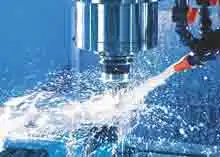 Cutting oil with anti-wear additives can significantly increase tool life by reducing friction between the tool and the job hotspot. These additives prevent built-up edges by forming a protective coating over the tool. The main benefits of anti-wear additives include
Cutting oil with anti-wear additives can significantly increase tool life by reducing friction between the tool and the job hotspot. These additives prevent built-up edges by forming a protective coating over the tool. The main benefits of anti-wear additives include
Friction Reduction: Anti-wear additives create a thin, protective film on the tool and workpiece surfaces. This minimizes friction and heat generation during cutting operations.
Wear Prevention: By forming a lubricating barrier, anti-wear additives effectively reduce tool wear. This extends tool life and reduces the need for frequent replacements.
Temperature Control: The reduced friction and improved heat dissipation provided by anti-wear additives help maintain optimal operating temperatures during machining.
Surface Finish Enhancement: Anti-wear additives contribute to achieving superior surface finishes by minimizing tool marks, abrasions, and defects on the workpiece.
An anti-wear additive is a chemical compound incorporated into metalworking fluids to improve performance. It helps reduce wear and tear on metal surfaces and improve tool life. These additives work by forming a protective layer on the metal surface, reducing friction, and preventing metal-to-metal contact. They are crucial in various metalworking fluids, including cutting oils, grinding fluids, soluble oils, and rolling oils, especially in applications subjected to high loads and temperatures.
Anti-wear additives operate in two ways depending on their chemistry. They either form a protective thin layer on the metal surface or adsorb on the interface or at the point of contact (POC). The selection of an anti-wear additive depends on factors such as the metal surface, type of fluid, chemical composition of the components, and stability with other ingredients. The protective layer formed by these additives significantly reduces friction, prevents metal-to-metal contact, and extends the life of tools and machinery.
These additives also play a crucial role in preventing the formation of built-up edge (BUE) on tools. BUE is a layer of material that can form on the cutting edge of a tool during metalworking operations, increasing friction and wear on the tool and reducing its lifespan. The continuous thin layer formed by anti-wear additives minimizes the coefficient of friction at the point of contact.
Typically, anti-wear additives are used in metalworking formulations at concentrations ranging from 5% to 10%. The exact percentage varies depending on the metalworking operation, type of metal, chemistry of the metalworking fluid (MWF), and its components. Traditionally, Zinc thiophosphates (ZDDP) were used as anti-wear additives, but they are now being replaced by amides and esters due to their impact on safety and the environment.
Benefits of Eco Anti Wear Additives
- Compatibility: Eco Anti Wear Additives are Compatible with semi synthetic, synthetic –Do not impart alkalinity with mineral base cutting oils – No separation of oils
- Non-hazardous Formulation: Eco Anti Wear Additives are allow formulators to make non-hazardous end product. Use of Eco Anti wear additives prevent formation of oxidation residues
- Improved tool life : Use of anti-wear additives reduced COF drastically & helps to improve the tool life
- Improves sump life : As these additive reduces the temperatures automatically reduces the sludge formation
- No Bad Odours – As these additives are fee from chlorine, phosphorus do not generate bad odours Does not generate chemical odour from the sump
- Very low addition levels –These are high concentration fluids so percentage of mixing is very minor & allows formulator a stability

